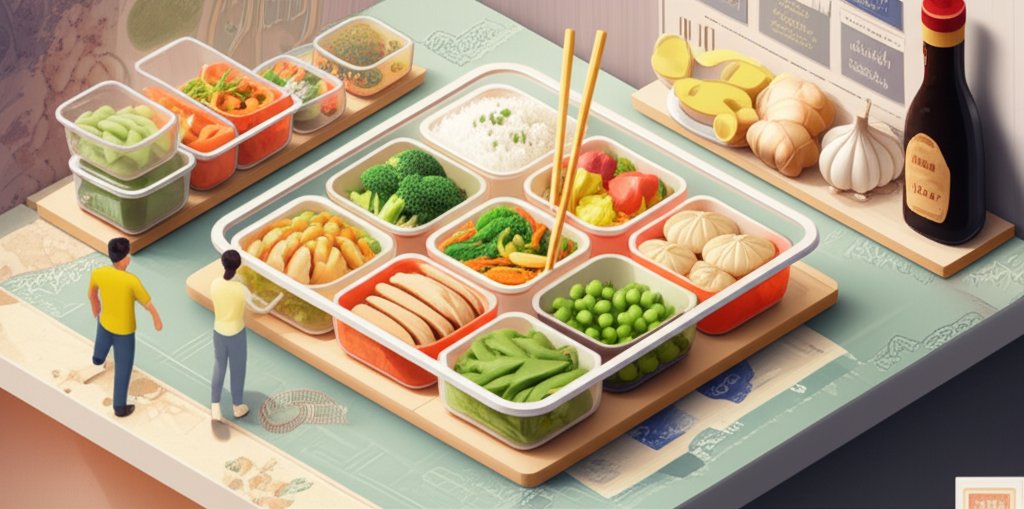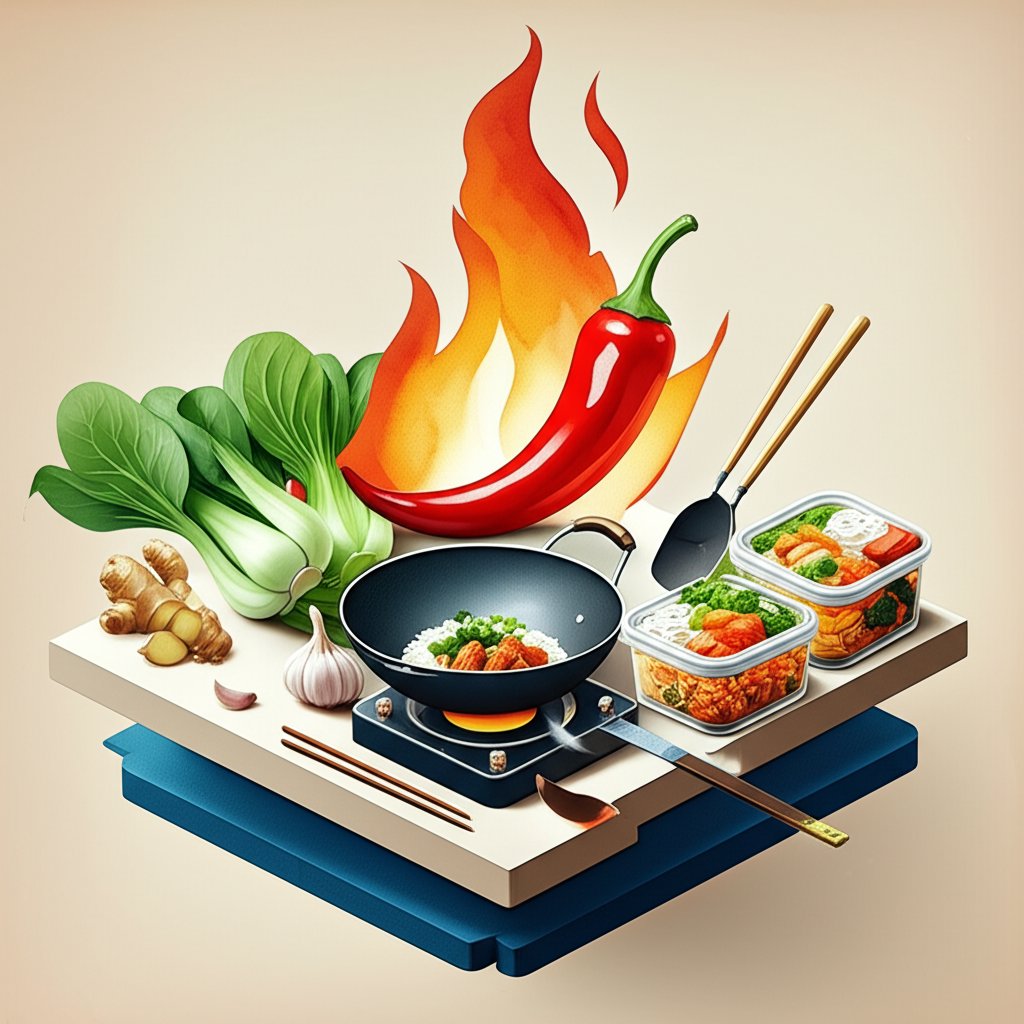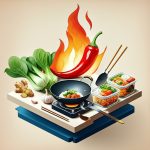Of course. Here is the detailed cluster article, crafted according to your specifications.
Tired of the same sad desk lunch? If another week of bland salads and boring sandwiches has you dreading midday, it’s time for a flavor intervention. Crafting vibrant, delicious asian meal prep recipes is the single best way to guarantee a week of exciting, satisfying meals that you’ll actually look forward to eating. It’s about more than just convenience; it’s about making your daily routine more enjoyable, one flavorful bite at a time.
Forget the idea that Asian cooking is too complex for a busy week. With the right strategy, a few key ingredients, and a little bit of planning, you can fill your fridge with everything from savory Korean beef bowls to zesty noodle salads.
At a glance: Your path to better meal prep
- Build a Foundation: Learn the “component method” to mix and match proteins, vegetables, and sauces for endless variety.
- Stock Your Pantry Smart: Discover the essential sauces and aromatics that form the backbone of countless Asian dishes.
- Master Three Core Recipes: Get step-by-step instructions for three foolproof meal prep recipes: a hearty bowl, a one-pan wonder, and a no-reheat salad.
- Unlock Storage Secrets: Find out which meals are best fresh and which are freezer-friendly champions, so nothing goes to waste.
- Solve Common Problems: Get quick answers to questions about soggy vegetables, prepping noodles, and keeping meals fresh all week.
Beyond the Recipe: A Framework for Effortless Asian Meal Prep
The secret to sustainable meal prep isn’t just finding a good recipe; it’s understanding the building blocks. Instead of thinking “I need to make five servings of Thai Chicken Curry,” think “I need to prep a protein, a grain, a vegetable, and a sauce.” This “component prep” approach gives you flexibility and prevents flavor fatigue.
While our broader guide to Flavorful Asian meal prep covers a wide range of ideas and inspirations, we’re going to focus here on the practical how-to. The four core components are:
- The Protein: Chicken thighs, ground turkey, marinated beef, firm tofu, or even edamame.
- The Carb/Base: Jasmine rice, brown rice, vermicelli noodles, udon, or even cauliflower rice or lettuce cups for a low-carb option.
- The Veggies: Steamed broccoli, roasted bell peppers, shredded carrots, wilted spinach, or fresh cucumbers and bean sprouts.
- The Flavor (Sauce/Marinade): This is where the magic happens. A good teriyaki, peanut, or gochujang-based sauce can transform simple ingredients into a crave-worthy meal.
By prepping these components separately, you can assemble different combinations throughout the week, keeping your lunches interesting and fresh.
Stocking Your Asian Meal Prep Pantry

You don’t need a specialty grocery store to get started. A few key items will unlock a huge range of recipes. Think of it in two tiers.
The Non-Negotiables
These are the foundational flavors you’ll reach for again and again.
- Low-Sodium Soy Sauce (or Tamari): The salty, umami backbone of countless marinades and sauces. Tamari is a great gluten-free alternative.
- Toasted Sesame Oil: Used as a finishing oil, its nutty, fragrant aroma is signature to many Korean and Chinese dishes. A little goes a long way.
- Rice Vinegar: Provides a mild, bright acidity that cuts through richness. Essential for dressings and pickling.
- Aromatics: Fresh ginger and garlic are non-negotiable. They build the base layer of flavor in almost every dish. You can buy them pre-minced in jars to save time.
The Flavor Boosters
Once you have the basics, add one or two of these to expand your culinary toolkit.
- Sriracha or Sambal Oelek: For a clean, straightforward kick of heat.
- Hoisin Sauce: A thick, sweet, and savory sauce perfect for glazes and stir-fries. Think of it as Asian barbecue sauce.
- Gochujang (Korean Chili Paste): A fermented chili paste that brings a complex sweet, savory, and spicy flavor. It’s the star of many Korean marinades.
- Fish Sauce: Don’t be afraid of the name. It adds an incredible depth of savory, umami flavor to Thai and Vietnamese dishes.
Your Weekly Meal Prep Playbook: Three Core Recipes
Let’s put the component method into practice. Here are three distinct types of asian meal prep recipes that cover different needs and cooking styles.
1. The Versatile Bowl: Korean-Inspired Beef Bowls
This is the quintessential meal prep bowl. A savory protein, a hearty grain, and crisp vegetables come together for a perfectly balanced meal. The marinade does all the heavy lifting, infusing the beef with incredible flavor.
- Why It Works for Meal Prep: The components store beautifully when kept separate. The beef is arguably even more flavorful on day two.
- Key Components:
- Protein: 1.5 lbs flank steak or sirloin, thinly sliced. (Or use ground beef/turkey for a budget-friendly option).
- Marinade: Mix 1/2 cup low-sodium soy sauce, 2 tbsp honey or maple syrup, 1 tbsp sesame oil, 4 minced garlic cloves, and 1 tbsp grated ginger.
- Carb: 2 cups uncooked Jasmine rice.
- Vegetable: 1 large head of broccoli, cut into florets.
- The Method (Step-by-Step):
- Marinate: Combine the sliced beef and marinade in a container. Let it sit for at least 30 minutes, or up to 8 hours in the fridge.
- Cook Grains: Cook the Jasmine rice according to package directions.
- Prep Veggies: While the rice cooks, steam the broccoli florets until tender-crisp.
- Cook Protein: Heat a large skillet or wok over high heat. Add the beef in a single layer (work in batches to avoid crowding the pan) and cook for 2-3 minutes per side until browned and cooked through.
- Meal Prep Assembly: Portion the rice, beef, and broccoli into individual airtight containers. You can drizzle any extra pan sauce over the beef and rice.
2. The One-Pan Wonder: Sheet Pan Teriyaki Chicken & Veggies
For those who despise doing dishes, the sheet pan meal is a game-changer. Everything cooks together on one pan, and the high heat of the oven creates a delicious caramelization on the chicken and vegetables.
- Why It Works for Meal Prep: Minimal cleanup and incredibly efficient. The flavors meld together beautifully in the oven. At just over 200 calories per serving (without rice), it’s a light but satisfying option.
- Key Components:
- Protein: 1.5 lbs boneless, skinless chicken breast or thighs, cut into 1-inch cubes.
- Vegetables: 1 red bell pepper, 1 head of broccoli, and 1 red onion, all chopped into bite-sized pieces.
- Sauce: Whisk together 1/2 cup soy sauce, 1/4 cup honey, 2 tbsp rice vinegar, 1 tbsp sesame oil, 2 cloves minced garlic, and 1 tsp grated ginger.
- The Method (Step-by-Step):
- Preheat: Set your oven to 400°F (200°C).
- Combine: On a large, rimmed baking sheet, toss the cubed chicken and chopped vegetables with about two-thirds of the teriyaki sauce.
- Roast: Spread everything in an even layer. Roast for 20-25 minutes, or until the chicken is cooked through and the vegetables are tender and slightly charred at the edges.
- Finish: Drizzle the remaining sauce over the hot chicken and vegetables.
- Meal Prep Assembly: Portion the chicken and vegetable mixture into containers. Serve as is, or with a side of pre-cooked brown rice or quinoa.
3. The No-Reheat Hero: Asian Noodle Salad with Peanut Dressing
Sometimes you don’t have access to a microwave. This cold noodle bowl is the perfect solution. It’s refreshing, packed with fresh vegetables and protein, and tastes incredible straight from the fridge.
- Why It Works for Meal Prep: It’s designed to be eaten cold. The flavors marinate and get even better over a day or two.
- Key Components:
- Base: 8 oz vermicelli rice noodles.
- Protein: Pre-cooked shredded rotisserie chicken, baked tofu, or shelled edamame.
- Veggies: Shredded carrots, thinly sliced cucumber, chopped scallions, and red bell pepper strips.
- Dressing: Whisk together 1/2 cup creamy peanut butter, 1/4 cup warm water, 3 tbsp soy sauce, 2 tbsp lime juice, 1 tbsp honey or maple syrup, and 1 tsp sambal oelek.
- The Method (Step-by-Step):
- Cook Noodles: Cook the rice noodles according to package directions (this usually just involves a quick soak in hot water). Drain and rinse with cold water.
- Prep Dressing: Whisk all dressing ingredients together until smooth. Add more water if needed to reach a pourable consistency.
- Combine: In a large bowl, toss the cooled noodles with your protein, vegetables, and about half the dressing.
- Meal Prep Assembly: Portion the noodle salad into containers. Store the remaining dressing in small, separate containers to add just before eating. This prevents the noodles from absorbing all the sauce overnight.
The Art of Storage: Making Your Meals Last

Not all asian meal prep recipes are created equal when it comes to storage. Knowing what to eat early in the week and what to save for later (or freeze) is key to avoiding food waste and disappointment.
Short-Term Stars (Eat within Days 1-3)
These dishes have ingredients that are best enjoyed fresh. Plan to eat them first.
| Recipe Type | Why It’s Best Fresh | Pro Tip |
|---|---|---|
| Salads with Fresh Greens | Lettuce and fresh herbs will wilt and become soggy over time. | Pack dressing separately and add right before serving. |
| Zucchini Noodle Dishes | Zoodles release water and can become mushy after a day or two. | If you must prep ahead, cook them very al dente (barely cooked). |
| Crispy-Coated Proteins | The crispy coating on dishes like Orange Chicken will soften in the fridge. | Reheat in an air fryer or oven to try and restore some crispiness. |
| Delicate Seafood (like Poke) | For food safety and best texture, raw fish dishes should be eaten the same day. | Opt for a cooked salmon or shrimp bowl for longer storage. |
Freezer-Friendly Champions (Perfect for Days 4-7 and Beyond)
These recipes freeze and reheat beautifully, making them perfect for stocking up.
| Recipe Type | Why It Freezes Well | Pro Tip |
|---|---|---|
| Curries (Thai, Indonesian) | The coconut milk or broth-based sauces prevent freezer burn and keep everything moist. | Freeze in individual portions. Thaw overnight in the fridge. |
| Braises (Filipino Adobo) | The flavors deepen upon freezing and reheating. The meat becomes even more tender. | Ensure the meat is fully submerged in the sauce before freezing. |
| Hearty Soups & Stews | Liquids protect the ingredients. Perfect for Indonesian Jackfruit Rendang or hot pots. | Leave a little headspace in the container to allow for expansion. |
| Minced Meat Dishes | Taiwanese Minced Pork or Asian Ground Turkey bowls freeze perfectly. | Freeze the meat mixture separately from the rice for best texture. |
Quick Answers to Common Meal Prep Questions
Q: How do I keep my stir-fry vegetables from getting soggy?
A: There are two secrets. First, don’t overcook them initially; they should be tender-crisp. Second, store the sauce separately. When you pack your meal, put the rice/noodles on the bottom, then the protein and veggies, and pack the sauce in a small container on the side. Mix it all together after reheating.
Q: Can I really meal prep noodles without them turning into a sticky mess?
A: Absolutely. After cooking and draining your noodles (udon, lo mein, etc.), rinse them briefly under cold water. Then, toss them with a tiny bit of sesame oil. This light coating prevents them from sticking together in the container. For ramen, always store the broth separately from the noodles and toppings.
Q: Is Asian meal prep healthy?
A: It’s as healthy as you make it! The beauty of meal prepping is that you control every ingredient. You can opt for low-sodium soy sauce, use lean proteins like ground turkey or tofu, load up on vegetables, and choose brown rice over white. Homemade sauces allow you to control the sugar and salt content, making them far healthier than most store-bought versions.
Q: I’m a total beginner. What’s the easiest recipe to start with?
A: The Sheet Pan Teriyaki Chicken is your best bet. It involves the least amount of active cooking time and cleanup. The oven does most of the work, and it’s very hard to mess up. It’s a huge confidence booster and delivers fantastic flavor for minimal effort.
Your First Step to a More Flavorful Week
Don’t try to overhaul your entire week at once. The goal is progress, not perfection. Start small.
This week, pick just one of the recipes above—the one that sounds most delicious to you. Go to the store, buy the ingredients for it, and prep just your lunches for the next three or four days.
By mastering one simple recipe, you’ll build the confidence and the pantry to explore more. Soon, you’ll be mixing and matching components like a pro, turning your busy weeks into a delicious culinary adventure. You’ve got this.
- Simple Asian Meal Prep Recipes to Spice Up Your Week - November 11, 2025
- Simple Asian Meal Prep Ideas For Healthy And Flavorful Weekday Meals - November 10, 2025
- Meal Prep Asian Food Made Easy for Delicious Weeknight Meals - November 9, 2025










